Miidera Temple 三井寺
|
Title   • File Name • File Name   • Date • Date   • Position • Position   |
|

Main entrance to Miidera (Onjoji) temple. It is the headquarters temple of the Tendai Jimon Buddhist Sect (founded by Priest Enchin) and former rival of Enryakuji temple on Mt. Hiei, also in Shiga. MAP
|
|

These photos were taken in both April during cherry blossoms season and in summer.
|
|

Daimon Gate (also called Niomon Gate) is the temple's front gate. Built in 1452 and transferred here from Jorakuji temple in Koka by Tokugawa Ieyasu in 1601. Important Cultural Property. 仁王門
|
|

Front of Niomon Gate. The name Miidera literally means "Three-Well Temple." It refers to three Emperors (Tenchi, Temmu, and Jito) who as newborns bathed in the temple's Akaiya well. "Mii" 御井 originally meant "sacred well.
|
|

Priest Enchin (Chisho-daishi) also used the sacred well water for a succession ceremony and called the temple, "Miidera" using the kanji for "three wells." The official name of "Onjoji" was given by Emperor Temmu. Back of Nio
|
|

Back of Niomon Gate.
|
|

Map of Miidera temple showing a variety of structures at the foot of Mt. Nagara (not Mt. Hiei). There are about 40 buildings, but you can enter only a few of them. It's not a huge complex, but allow at least 90 min. to see the major things.
|
|

Near the Niomon Gate is the Shaka-do Hall (also called Jiki-do 食堂) which worships the Shaka Nyorai statue. Dating from the early Muromachi Period, an Important Cultural Property. Photography is not allowed inside.
|
|

Steps going up to the Kondo Hall.
|
|

Kondo Main Hall, a National Treasure and Miidera's largest building. However, it was undergoing roof repairs in June 2008. Completed in fall 2008. 金堂
|
|

Kondo Hall
|
|

Miidera temple's Kondo Hall, a National Treasure and Miidera's main worship hall built in 1599 in Otsu. 金堂
|
|

Kondo Hall and cherry blossoms.
|
|

Kondo Hall and cherry blossoms.
|
|
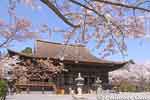
Kondo Hall and cherry blossoms.
|
|
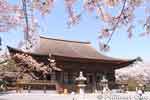
Miidera's Kondo Hall and cherry blossoms in Otsu.
|
|

Kondo Hall
|
|

Kondo Hall carvings
|
|

Kondo Hall carvings
|
|

Kondo Hall
|
|

Kondo Hall veranda
|
|

Kondo Hall roof
|
|

Kondo Hall corner wood beam
|
|

Inside Kondo Hall.
|
|

Inside Kondo Hall, built in 1599. Miroku Bosatsu statue is the object of worship.
|
|

Next to Kondo Hall is a small building called the Onjoji Akaiya, an Important Cultural Property. 閼伽井屋
|
|

Inside Onjoji Akaiya is the sacred spring whose water is drawn to be offered in front of the temple altar. The water was also used to bathe the newborn Emperor Tenji, Tenmu, and Jito. The name Miidera (Three Wells) comes from this spring.
|
|

This small building houses a temple bell which, according to legend, warrior monk Benkei from Enryakuji stole from Miidera and carried up to Enryakuji on Mt. Hiei.
|
|

It's a huge bell. After hearing the sound of the bell on Mt. Hiei, Benkei was disgusted with how it sounded and threw the bell back down the mountain.
|
|

Mii Bell Pavilion (Mii-no-Bansho) on the right. The small building on the left is a gift shop where you buy a ticket to ring the bell.
|
|

Next to the Kondo hall is the famous Mii Bell Pavilion (Mii-no-Bansho). It is one of the Omi Hakkei (Eight Views of Omi) depicted in ukiyoe woodblock prints. Dating from the Momoyama period, it is an Important Cultural Property.
|
|

There is a small opening where you can enter the bell pavilion to ring the gong. 鐘楼
|
|

It costs 300 yen to ring this bell once. (Not supposed to ring it more than once unless you pay again.) Also see my YouTube video here. 三井晩鐘
|
|

Inside the Miidera Bell Pavilion, the source of the "Evening Bell at Miidera temple."
|
|
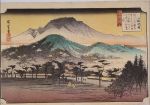
Hiroshige's woodblock print of Evening Bell at Miidera temple from his "Omi Hakkei" (Eight Views of Omi) series.
|
|

Hiroshige's woodblock print of Evening Bell at Miidera temple from his "Omi Hakkei" (Eight Views of Omi) series.
|
|

Lotus pond
|
|

Steps going to Issaikyo-zo Hall.
|
|

Issaikyo-zo Hall is a storehouse for all of the temple's Buddhist scriptures and valuable books. Built in the Muromachi Period and moved here from Yamaguchi Pref. in 1602 by Lord Mori Terumoto. Important Cultural Property. 一切経蔵
|
|

Inside Issaikyo-zo Hall is an octagonal, rotating Rinzo rack where the scriptures are stored.
|
|

Inside Issaikyo-zo Hall
|
|

Cherry blossoms in April.
|
|
|
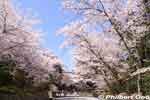
Miidera's cherry blossoms are also lit up at night. (See photos at bottom.)
|
|

Path to the To-in complex.
|
|

Gate to the To-in complex, Miidera's most sacred area where Enchin (Chisho-Daishi) is buried and enshrined. All the buildings are Important Cultural Properties. 唐院
|
|

In the center of the To-in complex is the Kancho-do Hall. Its a dojo exercise hall for entering the priesthood and conducting Buddhist initiation ceremonies. 潅頂堂
|
|

On the left of the Kancho-do is the Chonichi Goma-do Hall. Important Cultural Property. 長日護摩堂
|
|

On the right of the Kancho-do is the three-story pagoda (Sanju-no-to). It was moved from Fushimi Castle in Kyoto in 1601 by Tokugawa Ieyasu. Important Cultural Property. 三重塔
|
|
|

Miidera's Three-story pagoda (Sanju-no-to)
|
|
|
|
|
|

Miidera's Three-story pagoda (Sanju-no-to)
|
|

Behind the Kancho-do Hall is the Daishi-do Hall where Enchin is interred.
|
|

Another building in the To-in area.
|
|

When the temple founder was crossing this bridge, a temple in China was ablaze. When he sprinkled water from a well, a mist arose from beneath the bridge and flew to extinguish the burning temple in China. 村雲橋
|
|

View from the bridge during cherry blossom season, looking toward the Kondo Hall.
|
|
|

Stone wall and gate to Kangaku-in Hall at Miidera temple (Onjoji), school for priests and a National Treasure but closed to the public. 勧学院
|
|

Gate to Kangaku-in Hall, school for priests at Miidera temple in Otsu. Closed to the public.
|
|

This is the closest we can get to Kangaku-in Hall, a National Treasure at Miidera temple in Otsu.
|
|
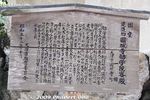
About Kangaku-in Hall.
|
|

Hydrangea in June
|
|

Hydrangea
|
|

Going toward the southern precinct of the temple, you see this Bimyoji temple with an 11-faced Kannon statue, an Important Cultural Property. The building was reconstructed in 1776. 微妙寺
|
|

Tendai Daishi statue
|
|
|
|

Shuho Kannon. Worship her and become prosperous. 衆宝観音
|
|

Bishamon-do Hall and maple leaves. Should return in fall.
|
|

Built in 1616, Bishamon-do Hall is an Important Cultural Property. 毘沙門堂
|
|

Bishamon-do Hall. 毘沙門堂
|
|

Steps leading to the Kannon-do Hall on a hill in the southern precinct of Miidera.
|
|

Side view of Kannon-do Hall.
|
|

Bell tower next to Kannon-do Hall.
|
|

Bell tower
|
|

Inside bell tower
|
|

Kannon-do Hall, Miidera temple, Shiga
|
|

Kannon-do Hall is the 14th temple in the Saigoku (Western Japan) pilgrimage circuit of 33 temples. Important Cultural Property 観音堂
|
|

Inside Kannon-do Hall
|
|

Incense burner inside Kannon-do Hall
|
|

Inside Kannon-do Hall
|
|

Statue inside Kannon-do Hall
|
|

Ema tablet
|
|

Ema tablet pavilion
|
|

In front of the Kannon-do Hall is the water basin for purification.
|
|
|

Moon-viewing stage 勧月舞台
|
|

On the left in the back are steps going up to the lookout deck. A must-see vantage point.
|
|

On the lookout deck.
|
|
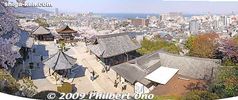
The lookout point gives the best views. The Kannon-do is on the left. Central Otsu can be seen in the distance as well as Lake Biwa.
|
|

Miidera temple
|
|
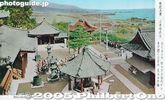
Vintage postcard view of the same scene in Miidera. Otsu was much less developed.
|
|

Kannon-do complex at Miidera temple, Shiga.
|
|
|
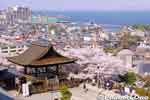
Moon-viewing stage 勧月舞台 and cherry blossoms at Miidera with Lake Biwa in the background.
|
|

Kannon-do on the left.
|
|

View of central Otsu which is experiencing a building boom along the lake shore. This has prompted local residents to seek a building height limit, otherwise the lake would disappear from view.
|
|

The lookout point is like a park with various monuments.
|
|

The stone marker on the right indicates where Emperor Meiji was when he visited here.
|
|

Monument dedicated to Shiga Prefectural police officers.
|
|

Soroban (Abacus) Monument
|
|
|

On the fringe of Miidera is Somon Gate 総門
|
|

Gate to Goho Zenjin-do Hall
|
|

Another gate to Goho Zenjin-do Hall
|
|

Goho Zenjin-do Hall worships a guardian deity for children. Pray here for a safe childbirth and healthy growth of your kids. 護法善神堂
|
|

Somewhat away from the central area of Miidera is another National Treasure called Kojo-in Kyakuden. Unfortunately, it's closed to the public. All you see is this wall and a roof.
|
|
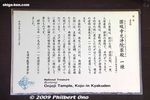
About Kojo-in Kyakuden. It also has a Japanese garden not open to the public. 光浄院客殿
|
|
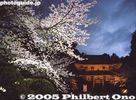
Cherry blossoms and the Niomon Gate at night in April.
|
|

Cherry blossoms at Miidera temple, Shiga.
|
|

Miidera cherry blossoms at night.
|
|
|

Beautiful cherry blossoms at night.
|
|
|

Cherry blossoms and three-story pagoda at night.
|
|

Miidera Station on the Keihan Ishiyama-Sakamoto Line is the closest station to Miidera temple (and Lake Biwa Canal).
|
|

Miidera Station platform.
|
|

Miidera Station platform.
|
|

Next to Miidera temple's southern boundary is Nagara Shrine. The shrine is not part of Miidera, but it is often included in maps of Miidera temple. 長等神社
|
|

Built in 1905, gate of Nagara Jinja Shrine.
|
|

In 860, Miidera Founder Enchin worshipped this shrine as the guardian deity of Miidera.
|
|

Nagara Shrine Honden Hall. The original shrine was atop the mountain, but it was later moved here in 1054 at the foot of Mt. Nagara to make it more accessible to worshippers.
|
|

Nagara Jinja Shrine
|
|
|
|
|
|
|